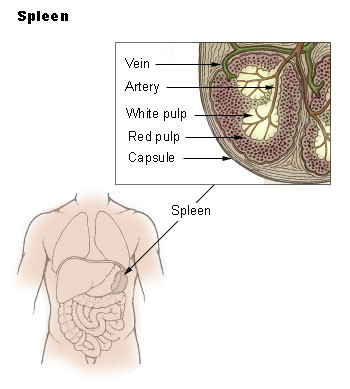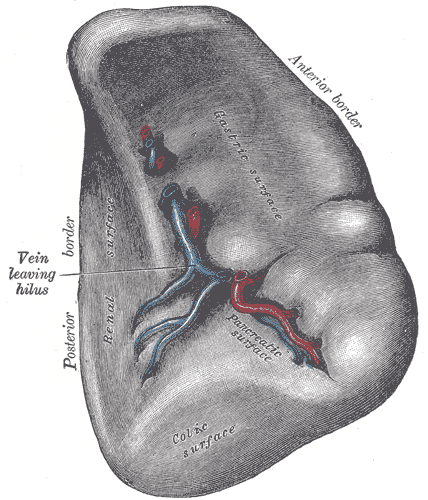Spleen Location, Anatomy and Function
What is the spleen?
The spleen is a spongy oval-shaped organ and is roughly the size of a person’s fist. It is located in the left upper quadrant (hypochondrium) of the abdomen, just under the left ribcage. The spleen has many important functions in the body involving the storage of blood and immune activity but it is not a vital organ. It can be removed surgically (splenectomy) without significantly impairing the quality of life although a person may be more prone to infections.
Location of the Spleen
Where is the spleen?
The spleen lies within the abdominal cavity and is almost entirely tucked behind the left ribcage. It is only palpable on the anterolateral abdominal wall (below the left costal margin) if it is enlarged. It sits against the diaphragm and the posterior abdominal wall in close relation to the ribs. Its location is helpful in protecting this very fragile organ but at the same time, the protective feature of the ribs can be to detriment of the spleen. In the event of a fractured rib, the spleen can be pierced by the rib and rupture.
The spleen lies behind the stomach, above the left colic flexure and to the side (laterally) of the left kidney. It lies underneath the diaphragm, in front and to the side of the left 9th to 11th, sometimes 12th, ribs. The spleen is connected to the greater curvature of the stomach by the gastrosplenic ligament, and to the left kidney by the splenorenal ligament. These ligaments contain the splenic vessels and are attached to the medial aspect (visceral surface) of the spleen.
Organs Surrounding the Spleen
The following organs and structures surround the spleen on the different sides.
- Anteriorly (front) lies the stomach.
- Posteriorly (back) and laterally(outer side) lies the left diaphragm, 9th to 11th ribs and the pleura of the lungs.
- Medially (inner side) lies the left kidney.
- Inferiorly (bottom) lies the colon, particularly the left colic flexure.
Picture from Wikimedia Commons
Anatomy of the Spleen
The approximate dimensions of the spleen is as follows :
- Length : 12 centimeters (about 5 inches)
- Width : 7 centimeters (about 3 inches)
- Thickness : 2 to 3 centimeters (about 1 inch)
The weight of the spleen may vary between 150 to 200 grams (5 to 7 ounces). The spleen can expand up to 3 times its size and this can significantly increase its weight.
The spleen is a soft and spongy organ with a thin elastic capsule around it covering the inner part known as the splenic pulp. Parts of the inner capsule carry the blood vessels and extends into the pulp. These extensions of the inner capsule is known as the trabechulae. The inner parts of the spleen is the parenchymal tissue known as the pulp, which is primarily made up of the red pulp and and smaller nodules known as the white pulp. Arteries that enter the pulp are surrounded by the white pulp nodules which contains large amounts of white blood cells that trap any invading pathogens. The blood then filters through the sinuses of the red pulp (sinusoids) and exit the spleen via the veins.
The visceral peritoneum surrounds the entire spleen except at the splenic hilum on the medial aspect of the spleen. The hilum is the site where the many branches of the splenic artery enter the spleen and the splenic vein exits. The splenic artery is derived from the celiac trunk, which is the major branch of the abdominal aorta. Just before it enters the spleen proper, the splenic artery divides into five or more branches. The splenic vein arises from several tributaries within the spleen and is joined by the inferior mesenteric vein initially and later with the superior mesenteric vein to form the hepatic portal vein.
Lymphatic fluid from the spleen empty into the lymph nodes at the splenic hilum. The lymph then passes through the pancreaticosplenic lymph nodes and then empties into the celiac nodes. The splenic nerve supply is derived from the celiac plexus (refer to Stomach Nerves).
Picture from Wikimedia Commons
The posterior and inferior borders of the spleen are somewhat smooth and rounded. The superior and anterior borders are sharper and notched. The visceral surface of the spleen contain the splenic hilum and also lies in close proximity to the kidney, stomach and colon. This surface is on the medial aspect of the spleen and is shaped in a manner to accommodate these organs.
Functions of the Spleen
Before birth, the spleen plays an important role in forming blood cells. After birth however, its role is to destroy worn out red blood cells and platelets, recycle the iron and globin component of the hemoglobin molecule. The red pulp is also a blood reservoir and stores red blood cells, platelets and monocytes until it is needed in the circulation. The elastic splenic capsule has smooth muscle within it and when required, it can contract thereby “squeezing” a substantial volume of blood into the circulation.
The spleen is the largest lymphatic organ in the body. It helps white blood cells to proliferate and initiates the appropriate immune response when necessary. Any microorganisms in the bloodstream are quickly trapped by the lymphocytes of the white pulp upon entering the spleen via the arteries. The lymphocytes can also exit the spleen and enter the general circulation to fight an infection at a distant site.






